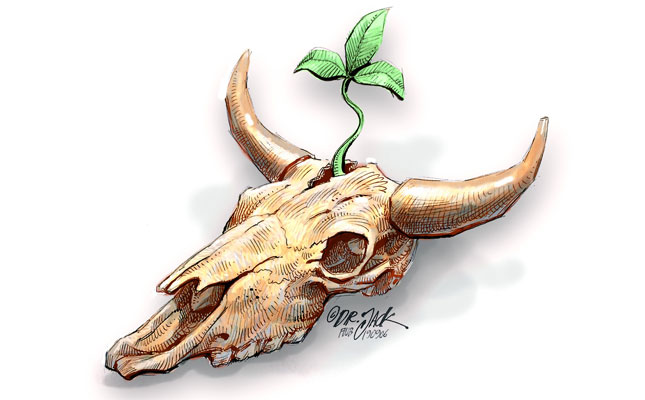
Desertification is land degradation in drylands due to human activities and, of course, climate change.
It is not limited to irreversible forms of land degradation, nor is it to be equated with desert expansion; it covers all forms of degradation that occur in drylands.
Drylands cover about 46,2% of the globe’s total land area and are home to three billion people. More than 20% of global plant biodiversity centres are located within drylands.
Plant species within these areas are characterised by high genetic diversity.
From 1961 to 2013, the annual area of drylands in drought increased, on average, by slightly more than 1% a year. Desertification hotspots, identified by a decline in vegetation between the 1980s and 2000s, extended to about 9,2% of drylands, affecting about 500 million people, in 2015.
The dryland population vulnerable to water stress, drought intensity and habitat degradation is projected to reach 178 million people by 2050 at 1,5°C global warming, 220 million at 2°C warming and 277 million at 3°C warming. Asia and Africa are forecast to have the highest number vulnerable to increased desertification.
Desertification has already led to reduced crop and livestock productivity, as well as the loss of biodiversity due to increasing aridity. On the steppe land of southwestern Algeria, for example, species richness decreased from 234 species in 1978 to 95 in 2011 after long periods of drought and human-driven degradation.
Other negative effects of desertification have been the spread of invasive alien plants, a rise in temperature in drylands, and an increased chance of veld fires in these areas due to the severity of droughts. In addition, the lower water retention capacity of degraded soil amplifies floods and soil erosion, and reduces annual intake of water to aquifers, worsening existing water scarcities.
Just as climate change can exacerbate land degradation processes, so desertification affects climate change. For example, soils contain large amounts of carbon, some of which could be released to the atmosphere due to desertification, with important repercussions for the global climate system.
The major human drivers of desertification are the expansion of croplands, a lack of sustainable land management, and increased pressure on land from population growth and urbanisation.
Proper land management
Managing land sustainably can help avoid or reduce desertification, mitigating climate change.
Sustainable land management (SLM) practices include reducing soil tillage and maintaining plant residue to keep soil covered, planting trees, growing a wider variety of crops, employing efficient irrigation methods, and using genetic improvements and varieties
for heat and drought tolerance.
For livestock, options include better grazing land management, improved manure management, higher-quality feed, and the use of breeds and genetic improvement.
Investment in SLM and land rehabilitation in drylands has a positive economic return. Each US dollar invested in land rehabilitation can have social returns of between US$3 and US$6 (about R46 and R92) over a 30-year period.
Most SLM practices can become financially profitable within three to 10 years. Unfortunately, many SLM practices are not widely adopted due to insecure land tenure, lack of access to credit and agricultural advisory services, and insufficient incentives for private land users.
Strengthening land-tenure security and expanding agricultural commercialisation are major contributors to the adoption of soil conservation measures.
Transitioning into the production of non-staple, high-value commodities and building a robust agro-industry sector reduce poverty more rapidly and help spur economic growth.
This, in turn, helps combat desertification and other forms of land degradation. (Poverty limits the capacity to adapt to climate change and the availability of financial resources to invest in SLM.)
Put another way, commercial farmers have easier access to, and are more likely to adopt, new technologies and strategies that mitigate both land degradation and the effects of climate change.
Reduction of food loss and waste can also help. This lowers greenhouse gas (GHG) emissions and contributes to climate change adaptation through reduction in the land area needed for food production.
From 2010 to 2016, global food loss and waste contributed 8% to 10% of total GHG emissions caused by humans. Currently, 25% to 30% of total food produced is lost or wasted.
Technical options, such as better harvesting techniques, on-farm storage, infrastructure, transport, packaging, retail and education can reduce food loss and waste across the supply chain.
Long-term benefits
Reducing and reversing land degradation, whether at the level of the individual farm or an entire watershed, provides cost-effective benefits, both immediate and long-term, to communities, starting with enhanced food security.
Many activities for combating desertification also help mitigate climate change. A number of desertification response options, such as improved management of crop and grazing lands, sustainable forest management and increased soil organic carbon content, do not
require land-use change or create demand for more land conversion.
In addition, reducing food wastage can reduce demand for land conversion, potentially freeing land and creating an opportunity for other climate change responses.
The views expressed in our weekly opinion piece do not necessarily reflect those of Farmer’s Weekly.
This article is taken from a published draft of the report titled ‘Climate Change and Land: An IPCC special report on climate change, desertification, land degradation, sustainable land management, food security, and greenhouse gas fluxes in terrestrial ecosystems’.











